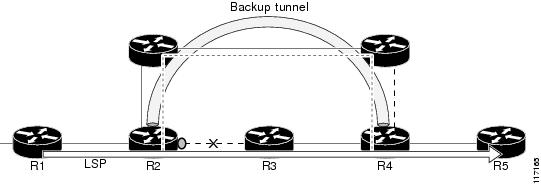Fast
Reroute
--A mechanism for protecting MPLS traffic engineering (TE) LSPs from link and node failure by locally repairing the LSPs at
the point of failure. This protection allows data to continue to flow on them while their headend routers attempt to establish
end-to-end LSPs to replace them. FRR locally repairs the protected LSPs by rerouting them over backup tunnels that bypass
failed links or nodes.
hop
--Passage of a data packet between two network nodes (for example, between two routers).
IGP
--Interior Gateway Protocol. An Internet protocol used to exchange routing information within an autonomous system.
interface
--A network connection.
IP
address
--A 32-bit address assigned to hosts using TCP/IP. An IP address belongs to one of five classes (A, B, C, D, or E) and is
written as four octets separated by periods (dotted decimal format). Each address consists of a network number, an optional
subnetwork number, and a host number. The network and subnetwork numbers together are used for routing, and the host number
is used to address an individual host within the network or subnetwork. A subnet mask is used to extract network and subnetwork
information from the IP address.
IP
explicit
path
--A list of IP addresses, each representing a node or link in the explicit path.
IS-IS
--Intermediate System-to-Intermediate System. OSI link-state hierarchal routing protocol based on DECnet Phase V routing,
where intermediate system (IS) routers exchange routing information based on a single metric to determine the network topology.
LDP
--Label Distribution Protocol. A standard protocol between MPLS-enabled routers to negotiate the labels (addresses) used to
forward packets.
link
--A point-to-point connection between adjacent nodes.
LSP
--label-switched path. A path that is followed by a labeled packet over several hops, starting at an ingress LSR and ending
at an egress LSR.
LSR
--label switching router. A Layer 3 router that forwards a packet based on the value of a label encapsulated in the packet.
MPLS
--Multiprotocol Label Switching. A method for forwarding packets (frames) through a network. It enables routers at the edge
of a network to apply labels to packets. ATM switches or existing routers in the network core can switch packets according
to the labels with minimal lookup overhead.
node
--An endpoint of a network connection or a junction common to two or more lines in a network. Nodes can be interconnected
by links, and serve as control points in the network.
OSPF
--Open Shortest Path First. A link-state hierarchical Interior Gateway Protocol (IGP) routing algorithm, derived from the
IS-IS protocol. OSPF features include least-cost routing, multipath routing, and load balancing.
router
--A network layer device that uses one or more metrics to determine the optimal path along which network traffic should be
forwarded. Routers forward packets from one network to another based on network layer information.
router
ID
--Something by which a router originating a packet can be uniquely distinguished from all other routers; for example, an IP
address from one of the router’s interfaces.
traffic
engineering
--The techniques and processes used to cause routed traffic to travel through the network on a path other than the one that
would have been chosen if standard routing methods had been used.
tunnel
--A secure communication path between two peers, such as two routers. A traffic engineering tunnel is a label-switched tunnel
that is used for traffic engineering. Such a tunnel is set up through means other than normal Layer 3 routing; it is used
to direct traffic over a path different from the one that Layer 3 routing could cause the tunnel to take.








 Feedback
Feedback